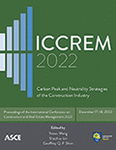Carbon Emissions of Operation Stage of Residential Buildings in Hot Summer and Warm Winter Zone in China
Publication: ICCREM 2022
ABSTRACT
Construction industry consumes a lot of construction materials and energy every year, generating 30%–40% of the world’s carbon emissions. Besides, in 2018, stock area of China’s residential buildings accounted for more than 80%, and carbon emissions accounted for more than 60%. Furthermore, due to dense population, developed economy, and many residential buildings in hot summer and warm winter zone, it is of high value to study its carbon emissions. Carbon emissions of operation stage of residential buildings in hot summer and warm winter zone in China includes air conditioning, lighting, elevator, and domestic appliances. In order to determine its carbon emissions, carbon emissions calculation model is established by using carbon emissions factor method. Taking a residential building in Guangzhou as an example, this paper calculates carbon emissions according to the established model. At the same time, this paper collects and arranges energy consumption of the case building and analyzes differences between model calculation results and measured data. The result shows that carbon emissions of air-conditioning system and lighting system accounts for 44% and 33%, respectively, which have great potential to reduce carbon emissions. Therefore, energy saving and emissions reduction of these two parts should be given priority consideration during construction in architectural design. This study provides some references for reducing carbon emissions of operation stage and also provides some suggestions to promote the development of prefabricated building in hot summer and warm winter zone in China.
Get full access to this article
View all available purchase options and get full access to this chapter.
REFERENCES
Cao, J. (2017). Study on Life Cycle Carbon Footprint Assessment of Residential Building. Chongqing University, Chongqing, China, 1–90. (in Chinese).
CABR (China Academy of Building Research). (2016). GB 50176-2016: Elevator technical conditions, China Architecture & Building Press, Beijing. (in Chinese).
CABR and CIBSDR (China Academy of Building Research and China Institute of Building Standard Design & Research). (2019). GB/T 51366-2019: Building carbon emission calculation standard, China Architecture & Building Press, Beijing. (in Chinese).
Institute of Building Mechanization, China Academy of Building Research. (2009). GB/T 10058-2009: Elevator technical conditions, China Standards Press, Beijing. (in Chinese).
IPCC. (1996). Climate change: The IPCC scientific assessment, Cambridge University Press, Shaftesbury.
Li, Y. Y., Zhang, K., and Li, J. L. (2021). “Comparative analysis of carbon emission throughout the life cycle of residential buildings and carbon reduction strategy.” Journal of Xi’an University of Architecture & Technology (Natural Science Edition), 53(05), 737–745. (in Chinese).
Liu, D. L., Liu, J. P., and Yang, L. (2013). “Review of building energy consumption calculation.” Heating Ventilating & Air Conditioning, 43(01), 95–99. (in Chinese).
Liu, L. Y. (2020). The Optimization Strategy for the Design Stage of a High-Rise Residence Based on the Measurement of Building Carbon Emission. Shantou University, Guangdong, China, 1–84. (in Chinese).
Lu, K. (2021). Integration of Life Cycle Carbon Emission and Life Cycle Cost using Building Information Modeling: Methodology and Case Study. Hefei University of Technology, Anhui, China, 163. (in Chinese).
Ministry of Ecology and Environment of the People’s Republic of China. (2020). “Baseline emission factors of China’s regional power grid for emission reduction projects in 2019.” <http://www.mee.gov.cn/ywgz/ydqhbh/wsqtkz/202012/t20201229_815386.shtml>(Dec. 29, 2020). (in Chinese).
Tsinghua University. (2018). JGJ/T 449-2018: Civil building green performance calculation standard, China Architecture & Building Press, Beijing. (in Chinese).
Zhang, T. (2013). Research on CO2 Emission Accounting Model and Evaluating System of Low-Carbon Residential Building Based on LCA. Anhui University of Technology, Anhui, China, 1–93. (in Chinese).
Zhou, X. (2012). Research of CO2 Emission of Urban Residential Buildings in Zhejiang Province Based on Life Cycle Assessment. Zhejiang University, Zhejiang, China, 1–69. (in Chinese).
Zou, R., Zhang, C. Y., Fang, T., and Wang, C. J. (2017). “Research on low-carbon construction strategy of campus in cold zone based on carbon balance accounting.” China Population, Resources and Environment, 27(04), 144–150. (in Chinese).
Information & Authors
Information
Published In
History
Published online: Dec 15, 2022
Authors
Metrics & Citations
Metrics
Citations
Download citation
If you have the appropriate software installed, you can download article citation data to the citation manager of your choice. Simply select your manager software from the list below and click Download.
